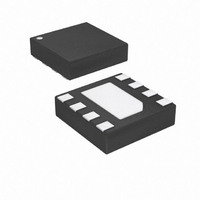ATTINY5-MAH Atmel, ATTINY5-MAH Datasheet - Page 24

ATTINY5-MAH
Manufacturer Part Number
ATTINY5-MAH
Description
IC MCU AVR 512B FLASH 8UDFN
Manufacturer
Atmel
Series
AVR® ATtinyr
Specifications of ATTINY5-MAH
Core Processor
AVR
Core Size
8-Bit
Speed
12MHz
Peripherals
POR, PWM, WDT
Number Of I /o
4
Program Memory Size
512B (256 x 16)
Program Memory Type
FLASH
Ram Size
32 x 8
Voltage - Supply (vcc/vdd)
1.8 V ~ 5.5 V
Data Converters
A/D 4x8b
Oscillator Type
Internal
Operating Temperature
-40°C ~ 85°C
Package / Case
8-UFDFN Exposed Pad
Core
AVR8
Lead Free Status / RoHS Status
Lead free / RoHS Compliant
Eeprom Size
-
Connectivity
-
Lead Free Status / Rohs Status
Details
- Current page: 24 of 169
- Download datasheet (5Mb)
7.1.2
7.1.3
7.1.4
7.2
7.3
24
Power Reduction Register
Minimizing Power Consumption
ATtiny4/5/9/10
ADC Noise Reduction Mode
Power-down Mode
Standby Mode
analog comparator can be powered down by setting the ACD bit in
Control and Status Register” on page
ADC is enabled (ATtiny5/10, only), a conversion starts automatically when this mode is entered.
When bits SM2:0 are written to 001, the SLEEP instruction makes the MCU enter ADC Noise
Reduction mode, stopping the CPU but allowing the ADC, the external interrupts, and the watch-
dog to continue operating (if enabled). This sleep mode halts clk
allowing the other clocks to run.
This mode improves the noise environment for the ADC, enabling higher resolution measure-
ments. If the ADC is enabled, a conversion starts automatically when this mode is entered.
This mode is available in all devices, although only ATtiny5/10 are equipped with an ADC.
When bits SM2:0 are written to 010, the SLEEP instruction makes the MCU enter Power-down
mode. In this mode, the oscillator is stopped, while the external interrupts, and the watchdog
continue operating (if enabled). Only a watchdog reset, an external level interrupt on INT0, or a
pin change interrupt can wake up the MCU. This sleep mode halts all generated clocks, allowing
operation of asynchronous modules only.
When bits SM2:0 are written to 100, the SLEEP instruction makes the MCU enter Standby
mode. This mode is identical to Power-down with the exception that the oscillator is kept run-
ning. This reduces wake-up time, because the oscillator is already running and doesn't need to
be started up.
The Power Reduction Register (PRR), see
vides a method to reduce power consumption by stopping the clock to individual peripherals.
When the clock for a peripheral is stopped then:
The peripheral should in most cases be disabled before stopping the clock. Clearing the PRR bit
wakes up the peripheral and puts it in the same state as before shutdown.
Peripheral shutdown can be used in Idle mode and Active mode to significantly reduce the over-
all power consumption. See
other sleep modes, the clock is already stopped.
There are several issues to consider when trying to minimize the power consumption in an AVR
Core controlled system. In general, sleep modes should be used as much as possible, and the
sleep mode should be selected so that as few as possible of the device’s functions are operat-
ing. All functions not needed should be disabled. In particular, the following modules may need
special consideration when trying to achieve the lowest possible power consumption.
• The current state of the peripheral is frozen.
• The associated registers can not be read or written.
• Resources used by the peripheral will remain occupied.
“Supply Current of I/O Modules” on page 123
82. This will reduce power consumption in idle mode. If the
“PRR – Power Reduction Register” on page
“ACSR – Analog Comparator
I/O
, clk
CPU
for examples. In all
, and clk
8127D–AVR–02/10
NVM
26, pro-
, while
Related parts for ATTINY5-MAH
Image
Part Number
Description
Manufacturer
Datasheet
Request
R

Part Number:
Description:
Manufacturer:
Atmel Corporation
Datasheet:

Part Number:
Description:
IC MCU AVR 512B FLASH SOT-23-6
Manufacturer:
Atmel
Datasheet:

Part Number:
Description:
IC MCU AVR 512B FLASH 8UDFN
Manufacturer:
Atmel
Datasheet:

Part Number:
Description:
IC MCU AVR 512B FLASH SOT-23-6
Manufacturer:
Atmel
Datasheet:

Part Number:
Description:
IC, MCU, 8BIT, 2K FLASH, 20SOIC
Manufacturer:
Atmel
Datasheet:

Part Number:
Description:
IC, MCU, 8BIT, 2K FLASH, 20PDIP
Manufacturer:
Atmel
Datasheet:

Part Number:
Description:
IC, MCU, 8BIT, 8K FLASH, 20PDIP
Manufacturer:
Atmel
Datasheet:

Part Number:
Description:
IC, MCU, 8BIT, 8K FLASH, 20SOIC
Manufacturer:
Atmel
Datasheet:

Part Number:
Description:
DEV KIT FOR AVR/AVR32
Manufacturer:
Atmel
Datasheet:

Part Number:
Description:
INTERVAL AND WIPE/WASH WIPER CONTROL IC WITH DELAY
Manufacturer:
ATMEL Corporation
Datasheet:

Part Number:
Description:
Low-Voltage Voice-Switched IC for Hands-Free Operation
Manufacturer:
ATMEL Corporation
Datasheet:

Part Number:
Description:
MONOLITHIC INTEGRATED FEATUREPHONE CIRCUIT
Manufacturer:
ATMEL Corporation
Datasheet:

Part Number:
Description:
AM-FM Receiver IC U4255BM-M
Manufacturer:
ATMEL Corporation
Datasheet:

Part Number:
Description:
Monolithic Integrated Feature Phone Circuit
Manufacturer:
ATMEL Corporation
Datasheet:










